Cover Page
Texts in Theoretical Computer Science
Title: Extremal Combinatorics With Applications in Computer Science, Second Edition
ISBN 9783642173639
Preface
Preface to the First Edition
Preface to the Second Edition
Notation
Contents
Notation
Part I The Classics
1 Counting.
2 AdvancedCounting.
3 Probabilistic Counting
4 The Pigeonhole Principle
5 Systems of Distinct Representatives
Part II Extremal Set Theory
6 Sunflowers
7 Intersecting Families
8 Chains and Antichains
9 Blocking Sets and the Duality
10 Density and Universality
11 Witness Sets and Isolation
12 Designs
Part III The Linear Algebra Method
13 The Basic Method
14 Orthogonality and Rank Arguments
15 Eigenvalues and Graph Expansion
16 The Polynomial Method
17 Combinatorics of Codes
Part IV The Probabilistic Method
18 Linearity of Expectation
19 The Lovász Sieve
20 The Deletion Method
21 The Second Moment Method
22 The Entropy Function
23 Random Walks
24 Derandomization
Part V Fragments of Ramsey Theory
25 Ramseyan Theorems for Numbers
26 The Hales–Jewett Theorem
27 Applications in Communication Complexity
References
Index
Part I The Classics
1. Counting
1.1 The binomial theorem
1.2 Selection with repetitions
1.3 Partitions
1.4 Double counting
1.5 The averaging principle
1.6 The inclusion-exclusion principle
Exercises
2. Advanced Counting
2.1 Bounds on intersection size
2.2 Graphs with no 4-cycles
2.3 Graphs with no induced 4-cycles
2.4 Zarankiewicz’s problem
2.5 Density of 0-1 matrices
2.6 The Lovász–Stein theorem
Exercises
3. Probabilistic Counting
3.1 Probabilistic preliminaries
3.2 Tournaments
3.3 Universal sets
3.4 Covering by bipartite cliques
3.5 2-colorable families
3.6 The choice number of graphs
Exercises
4. The Pigeonhole Principle
4.1 Some quickies
4.2 The Erdős–Szekeres theorem
4.3 Mantel’s theorem
4.4 Turán’s theorem
4.5 Dirichlet’s theorem
4.6 Swell-colored graphs
4.7 The weight shifting argument
4.8 Schur’s theorem
4.9 Ramseyan theorems for graphs
4.10 Ramsey’s theorem for sets
Exercises
5. Systems of Distinct Representatives
5.1 The marriage theorem
5.2 Two applications
5.3 Min–max theorems
5.4 Matchings in bipartite graphs
Exercises
Part II Extremal Set Theory
6. Sunflowers
6.1 The sunflower lemma
6.2 Modifications
6.3 Applications
Exercises
7. Intersecting Families
7.1 Ultrafilters and Helly property
7.2 The Erdős–Ko–Rado theorem
7.3 Fisher’s inequality
7.4 Maximal intersecting families
7.5 Cross-intersecting families
Exercises
8. Chains and Antichains
8.1 Decomposition in chains and antichains
8.2 Application: the memory allocation problem
8.3 Sperner’s theorem
8.4 The Bollobás theorem
8.5 Strong systems of distinct representatives
8.6 Union-free families
Exercises
9. Blocking Sets and the Duality
9.1 Duality
9.2 The blocking number
9.3 Helly-type theorems
9.4 Blocking sets and decision trees
9.5 Blocking sets and monotone circuits
Exercises
10. Density and Universality
10.1 Dense sets
10.2 Hereditary sets
10.3 Matroids and approximation
10.4 The Kruskal–Katona theorem
10.5 Universal sets
10.6 Paley graphs
10.7 Full graphs
Exercises
11. Witness Sets and Isolation
11.1 Bondy’s theorem
11.2 Average witnesses
11.3 The isolation lemma
11.4 Isolation in politics: the dictator paradox
Exercises
12. Designs
12.1 Regularity
12.2 Finite linear spaces
12.3 Difference sets
12.4 Projective planes
12.5 Resolvable designs
Exercises
Part III The Linear Algebra Method
13. The Basic Method
13.1 The linear algebra background
13.2 Graph decompositions
13.3 Inclusion matrices
13.4 Disjointness matrices
13.5 Two-distance sets
13.6 Sets with few intersection sizes
13.7 Constructive Ramsey graphs
13.8 Zero-patterns of polynomials
Exercises
14. Orthogonality and Rank Arguments
14.1 Orthogonal coding
14.2 Balanced pairs
14.3 Hadamard matrices
14.4 Matrix rank and Ramsey graphs
14.5 Lower bounds for boolean formulas
Exercises
15. Eigenvalues and Graph Expansion
15.1 Expander graphs
15.2 Spectral gap and the expansion
15.3 Expanders and derandomization
Exercises
16. The Polynomial Method
16.1 DeMillo–Lipton–Schwartz–Zippel lemma
16.2 Solution of Kakeya’s problem in finite fields
16.3 Combinatorial Nullstellensatz
Exercises
17. Combinatorics of Codes
17.1 Error-correcting codes
17.2 Bounds on code size
17.3 Linear codes
17.4 Universal sets from linear codes
17.5 Spanning diameter
17.6 Expander codes
17.7 Expansion of random graphs
Exercises
Part IV The Probabilistic Method
18. Linearity of Expectation
18.1 Hamilton paths in tournaments
18.2 Sum-free sets
18.3 Dominating sets
18.4 The independence number
18.5 Crossings and incidences
18.6 Far away strings
18.7 Low degree polynomials
18.8 Maximum satisfiability
18.9 Hash functions
18.10 Discrepancy
18.11 Large deviation inequalities
Exercises
19. The Lovász Sieve
19.1 The Lovász Local Lemma
19.2 Disjoint cycles
19.3 Colorings
19.4 The k-SAT problem
Exercises
20. The Deletion Method
20.1 Edge clique covering
20.2 Independent sets
20.3 Coloring large-girth graphs
20.4 Point sets without obtuse triangles
20.5 Affine cubes of integers
Exercises
21. The Second Moment Method
21.1 The method
21.2 Distinct sums
21.3 Prime factors
21.4 Separators
21.5 Threshold for cliques
Exercises
22. The Entropy Function
22.1 Quantifying information
22.2 Limits to data compression
22.3 Shannon entropy
22.4 Subadditivity
22.5 Combinatorial applications
Exercises
23. Random Walks
23.1 The satisfiability problem
23.2 Random walks in linear spaces
23.3 Random walks and derandomization
Exercises
24. Derandomization
24.1 The method of conditional probabilities
24.2 The method of small sample spaces
24.3 Sum-free sets: the algorithmic aspect
Exercises
Part V Fragments of Ramsey Theory
25. Ramseyan Theorems for Numbers
25.1 Arithmetic progressions
25.2 Szemerédi’s cube lemma
25.3 Sum-free sets
25.4 Sum-product sets
Exercises
26. The Hales–Jewett Theorem
26.1 The theorem and its consequences
26.2 Shelah’s proof of HJT
Exercises
27. Applications in Communication Complexity
27.1 Multi-party communication
27.2 The hyperplane problem
27.3 The partition problem
27.4 Lower bounds via discrepancy
27.5 Making non-disjoint coverings disjoint
Exercises
References
Index
Symbols
A
B
C
D
E
F
G
H
I
J
K
L
M
N
O
P
Q
R
S
T
U
V
W
Z
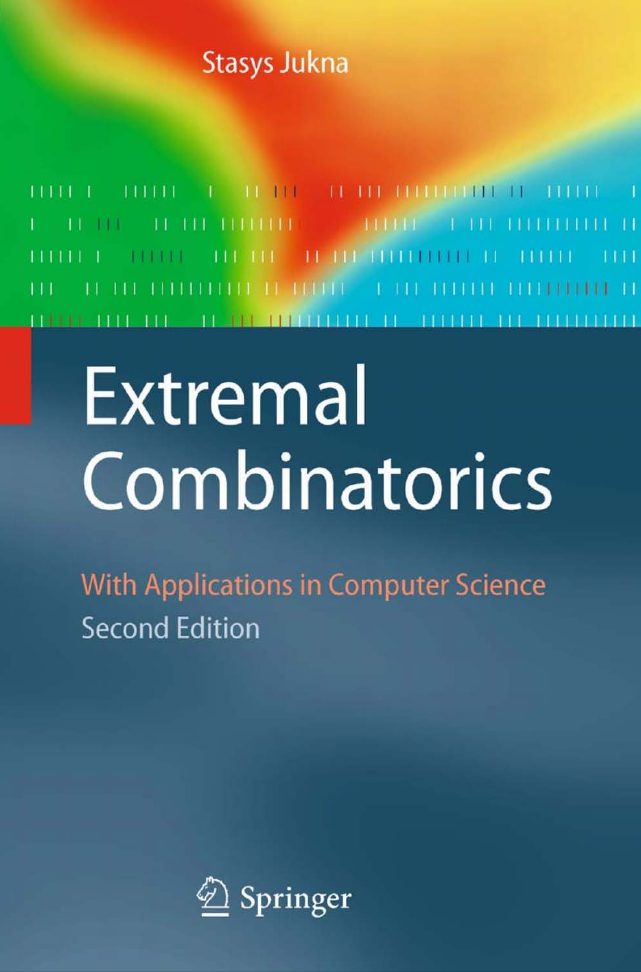
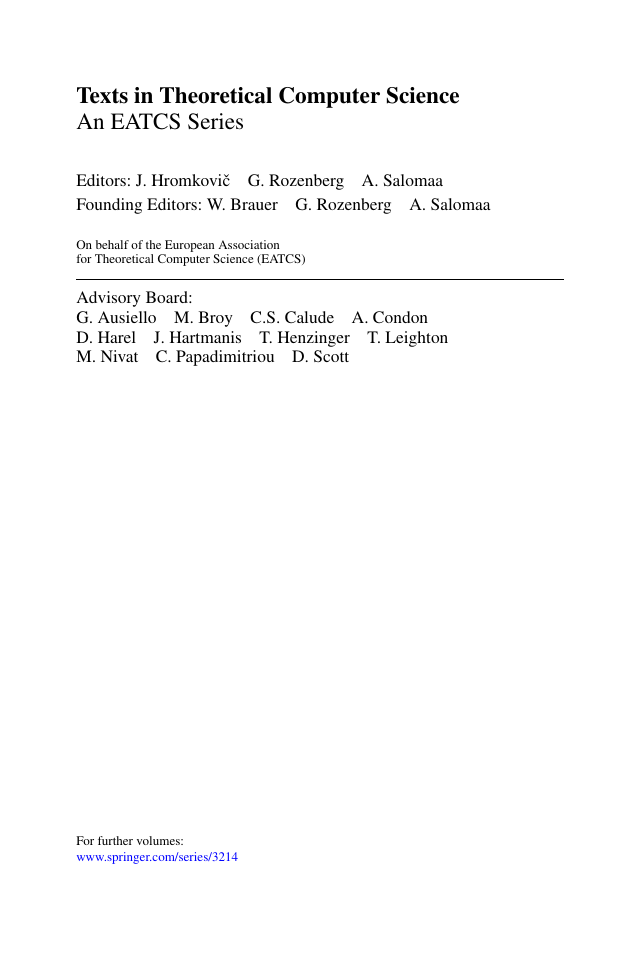
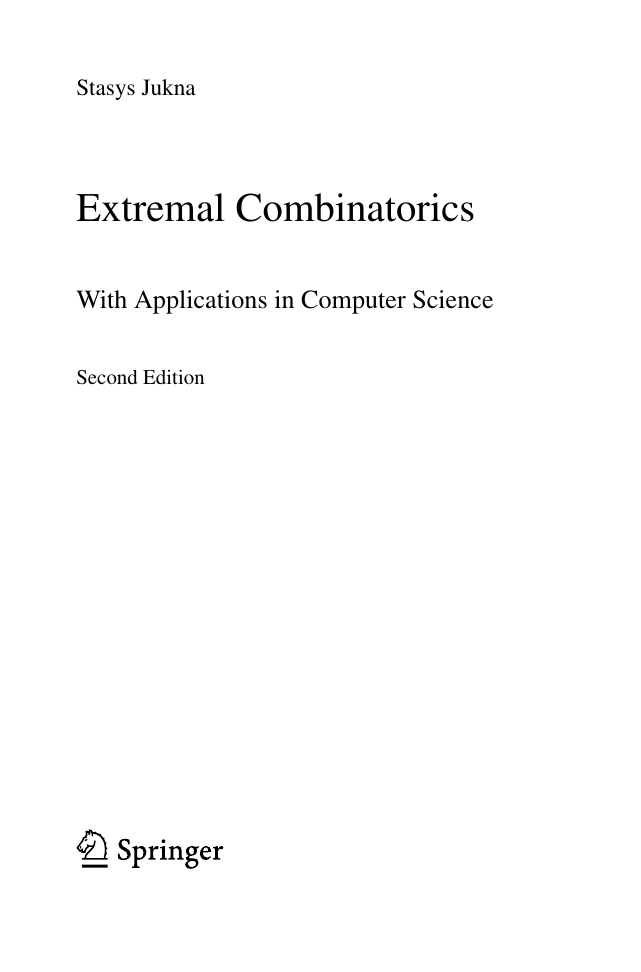
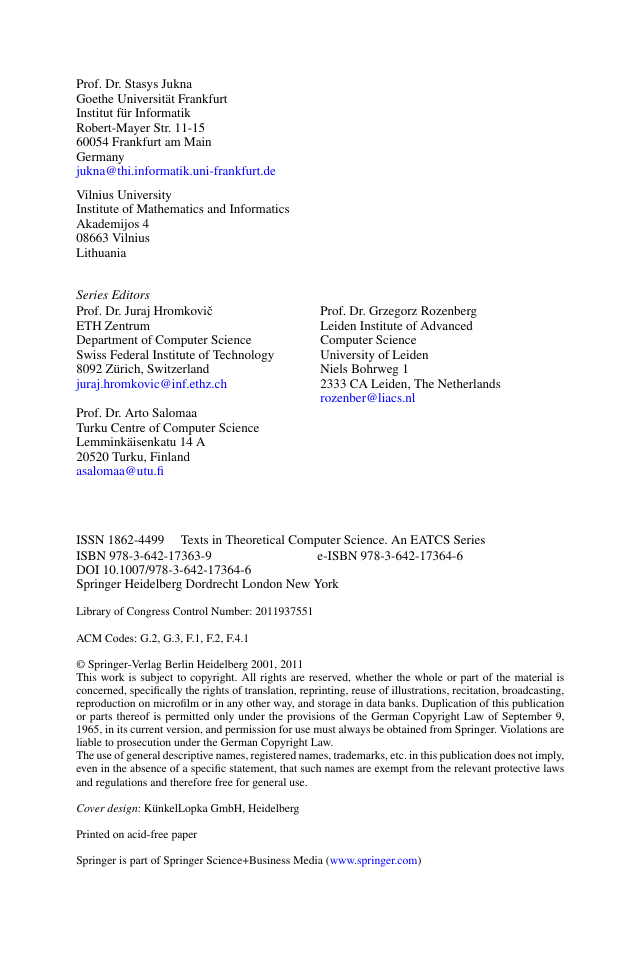

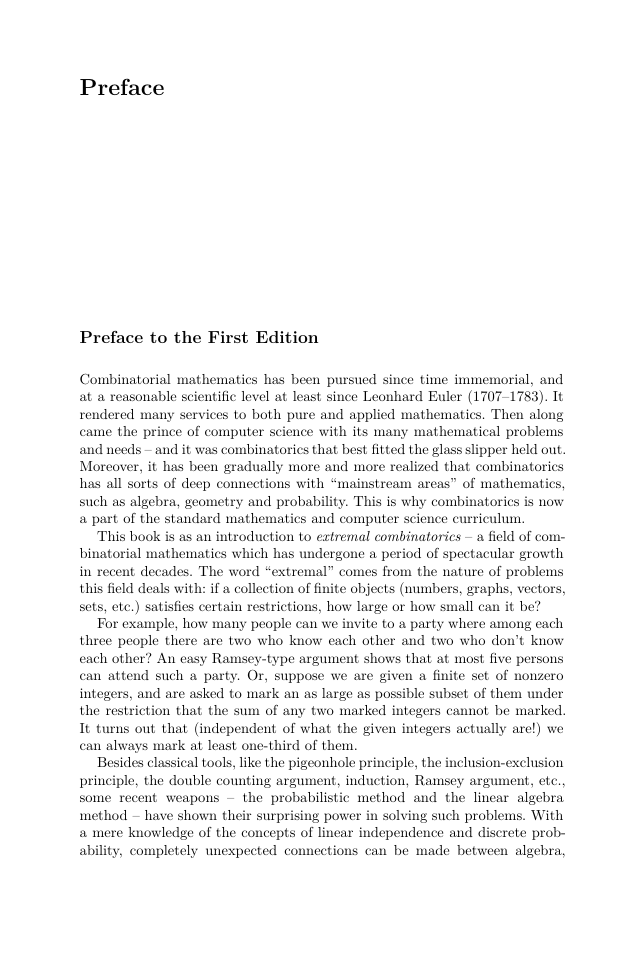
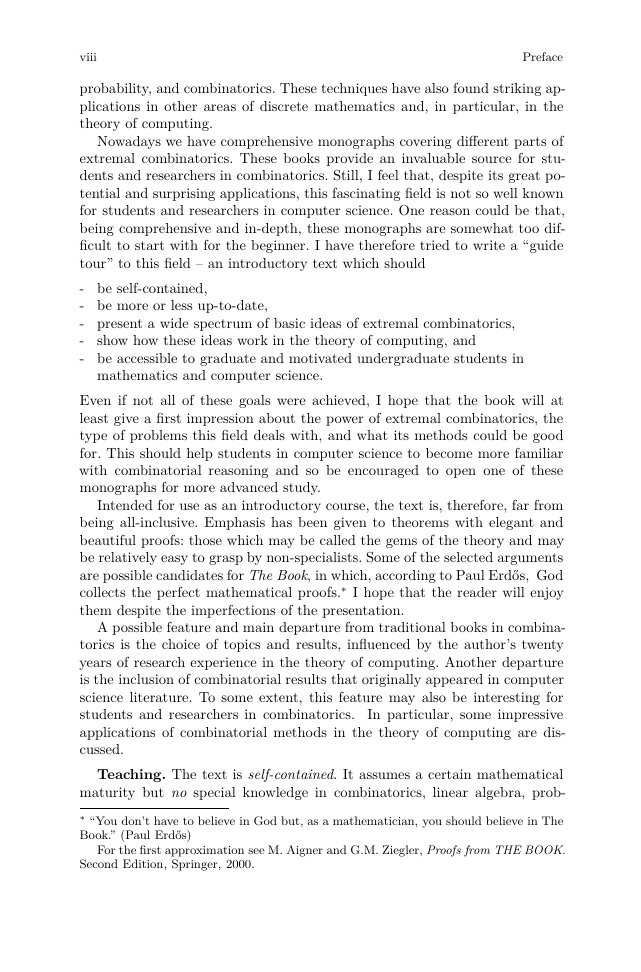
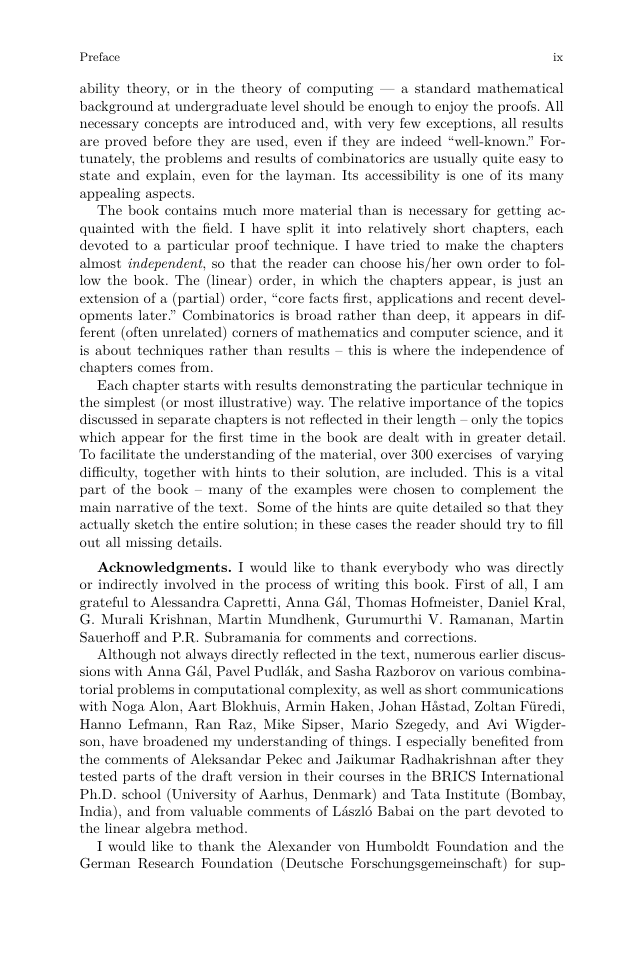








 2023年江西萍乡中考道德与法治真题及答案.doc
2023年江西萍乡中考道德与法治真题及答案.doc 2012年重庆南川中考生物真题及答案.doc
2012年重庆南川中考生物真题及答案.doc 2013年江西师范大学地理学综合及文艺理论基础考研真题.doc
2013年江西师范大学地理学综合及文艺理论基础考研真题.doc 2020年四川甘孜小升初语文真题及答案I卷.doc
2020年四川甘孜小升初语文真题及答案I卷.doc 2020年注册岩土工程师专业基础考试真题及答案.doc
2020年注册岩土工程师专业基础考试真题及答案.doc 2023-2024学年福建省厦门市九年级上学期数学月考试题及答案.doc
2023-2024学年福建省厦门市九年级上学期数学月考试题及答案.doc 2021-2022学年辽宁省沈阳市大东区九年级上学期语文期末试题及答案.doc
2021-2022学年辽宁省沈阳市大东区九年级上学期语文期末试题及答案.doc 2022-2023学年北京东城区初三第一学期物理期末试卷及答案.doc
2022-2023学年北京东城区初三第一学期物理期末试卷及答案.doc 2018上半年江西教师资格初中地理学科知识与教学能力真题及答案.doc
2018上半年江西教师资格初中地理学科知识与教学能力真题及答案.doc 2012年河北国家公务员申论考试真题及答案-省级.doc
2012年河北国家公务员申论考试真题及答案-省级.doc 2020-2021学年江苏省扬州市江都区邵樊片九年级上学期数学第一次质量检测试题及答案.doc
2020-2021学年江苏省扬州市江都区邵樊片九年级上学期数学第一次质量检测试题及答案.doc 2022下半年黑龙江教师资格证中学综合素质真题及答案.doc
2022下半年黑龙江教师资格证中学综合素质真题及答案.doc